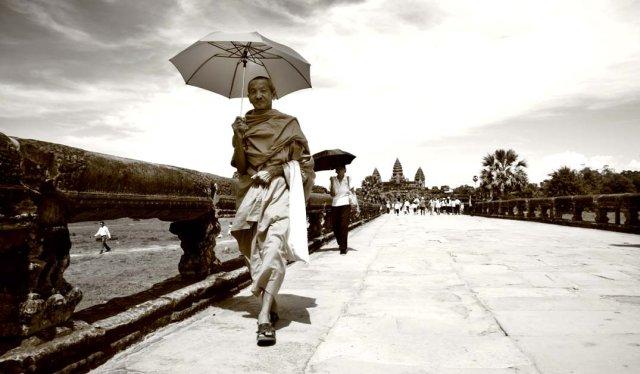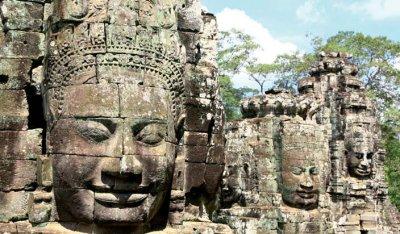InsideOut: Business in Cambodia
 Photography: Gordon Jones
Photography: Gordon Jones
A regular column concerning business in an emerging market, and its relationship with Japan
By Gordon Jones
The Kingdom of Cambodia, wedged uneasily between its larger and historically expansionist neighbors, Vietnam and Thailand, has a beauty and smile which belies its dark past. But scars remain and recent decades have been a difficult struggle to promote recovery and reconciliation.
For most people, Cambodia evokes two extreme images: the wonders of the Angkor civilization with its magnificent temples and the horrors of Pol Pot’s Khmer Rouge and the “Killing Fields,” which took the lives of 1.7 million of its people during the 1970s.
By any measure, Cambodia is a poor country. Annual GDP per capita is below US$600,
and UNICEF estimates that at least one third of the 14.2 million population struggle to survive below the poverty line of US$1 per day, with average life expectancy just 59 years and infant mortality rates perhaps the highest in the Asian region. Currently, Cambodia is ranked 131 (of 177) in the United Nations’ ‘Human Development Index’ and 162 (of 179) in Transparency International’s ‘Corruption Perceptions Index.’
However, despite a formidable list of development challenges, Cambodia appears to be making some progress in its efforts to reduce poverty and strengthen its economy, albeit from a low base. GDP growth rose on average by 9% per annum during the last decade (peaking above 13% in 2005) and has started attracting increased foreign investment: key for diversifying the economy and moving beyond a dependence on overseas aid.
Key focus sectors for investment are agriculture (improving the efficiency and agribusiness potential of Cambodia’s richly endowed farmlands and waterways, which already contribute to one-third of the GDP and two-thirds of employment); tourism (promoting Cambodia’s obvious potential and increasing revenues from a record 2 million visitors in 2007 to 3.2 million by 2010); industry (modernizing infrastructure and achieving a higher ratio of value-added manufacturing) and services (improved health and education coverage, and expansion of financial services).

Other lucrative sectors, notably the current property development surge, the ongoing export of minerals and timber, together with plans for exploring Cambodia’s oil and gas reserves and hydro-electric projects along the Mekong River, are exciting commercial interest. Conversely that process has added to inflationary pressures, accusations and concerns about “shady deals,” exploitation and profiteering, with little or no regard for the longer-term environmental and social impact.
The authoritarian rule of Prime Minister Hun Sen (since 1985) has undoubtedly brought a measure of political stability and improved security to the country, though serious issues remain regarding endemic corruption, poor governance and the weak rule of law, which have hindered the flow of aid, trade and investment.
Japan and Cambodia
Japan has been a vital contributor to Cambodia’s rehabilitation and reconstruction since the high-profile UN Transitional Authority (UNTAC) mission and elections in 1993: providing some US$1.2 billion in total overseas development assistance (ODA) during the period since 1992, and remains Cambodia’s top donor country.
In an interview with Pou Sothirak, Cambodia’s Ambassador to Japan, he emphasizes the special relationship between Japan and his country; the importance of continued Japanese aid assistance and hopes for a higher degree of Japanese FDI. Despite its generous aid, Japan ranked outside the Top 10 in 2006 in terms of FDI, behind a host of Asian countries. Total trade between Japan and Cambodia reached just US$249 million in 2007 (compared to US$11.8 billion with Vietnam and US$43.8 billion with Thailand).
At the corporate level, there are some notable Japanese interests in Cambodia such as popular apparel brand Uniqlo, now preparing for expanded Asian sourcing to include Vietnam and Cambodia as part of its “China+1” strategy. Additionally, Mitsubishi has co-signed with BHP Billiton, an exclusive agreement for exploration of bauxite in eastern Cambodia. Mitsui is also acquiring a 30% share in Cambodia’s ‘Block A’ off-shore oil and gas development concessions—both expected to start seeing returns from 2009.
For most companies, however, and even trade promotion authorities such as JETRO, Cambodia is considered “too small” and un-strategic to merit special focus and is typically ‘covered’ from the larger neighboring markets, primarily for trade rather than investment.
That said, it has recently been noted that some of the more than 1,200 Japanese companies currently operating in Thailand are seriously considering Cambodia for possible partial relocation in search of lower labor costs.
Companies currently operating in Thailand are seriously considering Cambodia for possible partial relocation in search of lower labor costs
Ambassador Sothirak concedes that “more confidence building measures” are required, but emphasizes that his government is “committed to ASEAN integration, fulfilling its WTO obligations and doing more to promote investment and reduce poverty levels.” He points to the ‘one-stop shop’ approach of the Council for the Development of Cambodia and the June 2007 signing of the Japan-Cambodia ‘Liberalization, Promotion & Protection of Investment Agreement’ as important vehicles for assisting further investment.
Still, as in most such ‘frontier markets,’ Japanese companies seldom strive for ‘1st mover advantage’ and, in the case of Cambodia, will likely let other Asian countries pave the way, increasingly China, which has now become Cambodia’s largest overall trading partner and investor. No doubt, there is money to be made in Cambodia for those companies and investors flexible enough in their approaches to ‘opportunity risk’ and able to hook up with reliable and effective local partners.
Economically, Cambodia is moving in the right direction but progress remains fragile, with a daunting array of development deficiencies still to be overcome. Just like so many centuries before, internal leadership and external pressures remain the determining factors for enduring peace and prosperity in this little land in between.
Japanese Development Efforts
If the heavens could weep over a people’s suffering, Cambodia would never know drought.”
So said one prominent observer in the mid- 1980s but, despite the end of the Khmer Rouge terror, Cambodia’s malaise continues— stark poverty, land-mines, HIV/AIDS. The list goes on, as does that of the multitude of international agencies and charities trying to assist. Worthy of attention are two Japan-based organizations, focused on providing skills, dignity and hope for Cambodia’s predominantly rural poor.
Japan Relief for Cambodia (JrfC) was established in 1993 by Bernie Krisher (Newsweek’s ex-Bureau Chief in Tokyo, famous for his 1975 exclusive interview with Emperor Hirohito), who has known Cambodia since the 1960s. “My investment is in the future and the children,” says Krisher, who has driven an impressive array of donor actions focused on improving health, education and information, including building more than 400 primary schools, the ‘New Life’ orphanage, the ‘Hope Hospital’ for nursing/teaching, the ‘Bright Future Kids’ and ‘Girls Be Ambitious’ programs.
 Photography courtesy of Kamonohashi-project
Photography courtesy of Kamonohashi-project
Applying technology to help bridge the digital divide has brought forth initiatives such as the ‘Motoman’ motorcycle roaming service providing internet coverage to rural schools; the ‘VillageLeap’ rural e-commerce project and ‘Operation Village Health’ telemedicine project, in cooperation with several US medical centers.
The ‘Kamonohashi-project’ was co-founded in 2002 by Murata Sayaka after visiting Cambodia and witnessing the pitiful existence of young mothers and children prone to exploitation and abuse. Specifically targeting the eradication of human trafficking and child prostitution, the project provides educational and vocational support for rural Cambodians to develop livelihoods and a more secure future. The ‘community factory’ initiative, which helps villagers to learn, produce and sell handicrafts, now has more than 50 trainees and is looking to expand its coverage.
Kunihiko Kabe, Manager of the project says “we attach great importance to helping rural Cambodians gain a measure of independence… providing support for them to get going and keep going under their own steam.” JI
www.cambodiaschools.com
www.girlsbeambitious.org
www.kamonohashi-project.net





